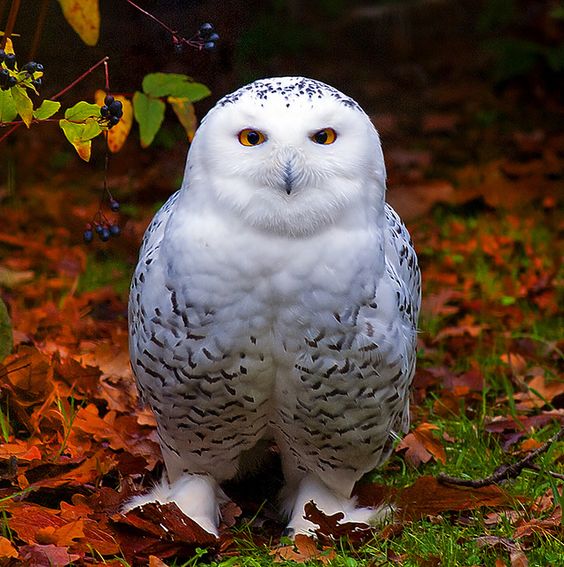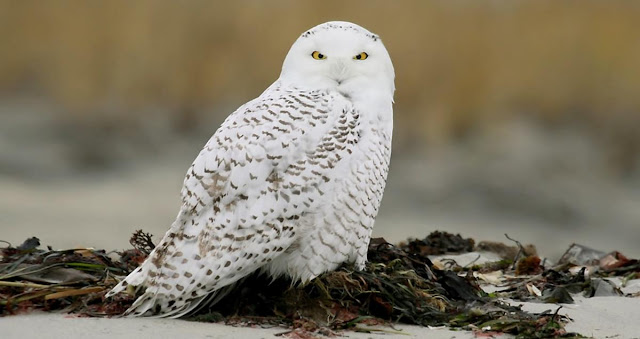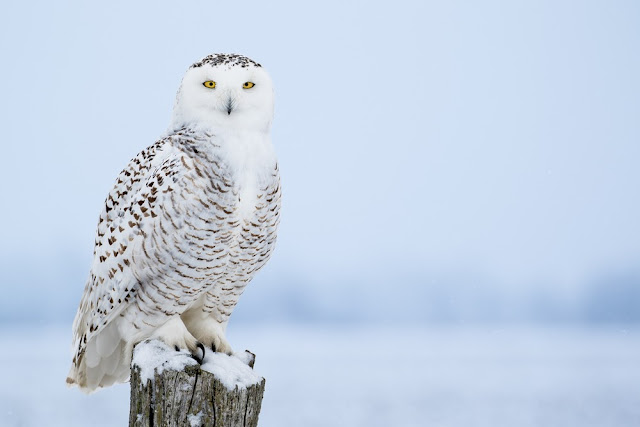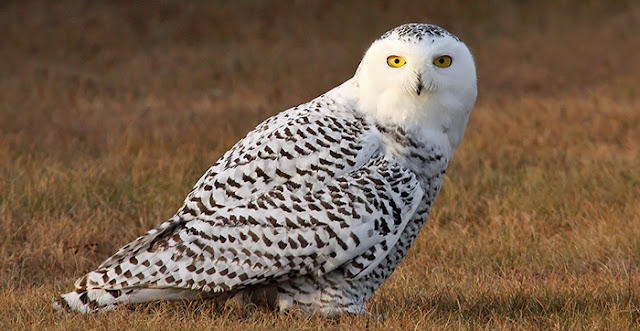A large, powerful owl of the high Arctic tundra, colored for camouflage during northern winters. In summer it may be nomadic, concentrating and nesting where there are high populations of the small rodents called lemmings. At other times it takes a wide variety of prey, including birds as big as geese.Males are almost all white, while females have more flecks of black plumage. Juvenile snowy owls have black feathers until they turn white.During some winters, large numbers of Snowy Owls appear south of the Canadian border; those that stop in towns and cities invariably cause a stir and attract media attention.
Range
In North America, snowy owls are found during the breeding season from the western Aleutians in Alaska to northeastern Manitoba (Churchill), northern Quebec and northern Labrador in Canada. In the winter, they can regularly be found in the northern United States. Sporadically they can be found as far south as central California as well as in Texas and Florida.
Behavior
Snowy Owls do a lot of sitting. They sit still in the same spot for hours, occasionally swiveling their head or leaning forward and blinking their big, yellow eyes to get a closer look at something. When they hunt, they use extraordinary vision and hearing to draw a bead on their prey—maybe a vole scurrying beneath the snow—and then fly, or even run, over to pounce on it. If successful, they’ll down the rodent headfirst in a single gulp. On their breeding grounds, male Snowy Owls execute a fascinating mating display. First the male rises into the air with exaggerated wingbeats in an undulating flight, holding a lemming in his bill or talons. Then he descends to the ground with wings flapping or held in a "V." He drops the prey on the ground, stands erect, then lowers his head and fans his tail as the female approaches. To defend his territory from another Snowy Owl, a male lowers his head and sticks it forward, extending his wings and raising the feathers on his neck and back to seem bigger. To defend against other species, Snowy Owls have been known to dive-bomb and strike at humans. Once it was reported that a Snowy Owl attacked a pair of arctic wolves.
Habitat
Generally, the habitat of the snowy owl comprises places of low elevation such as those at 600 feet. However, there are some species that breed in mountains that are at 3,000 feet elevations. To be specific, the habitat consists of regions with low and sparse vegetation―open land usually consisting of peaty soil covered with heather, bracken, and moss, open fields, valley floors, salt and freshwater meadows, lakeshores, marshes, and marine coastlines. This bird is very rarely found in forest areas, spending time perching in trees. It prefers living in holes that have been hollowed out. The regions of the Arctic tundra are known to be its breeding ground. Its habitat is greatly influenced by the distribution of mammals such as lemmings and other small rodents, as they make up for its primary diet. During winter, this bird mostly houses in farming areas with open fields of low stubble, marshes, and dunes.
Colour Pattern
Snowy Owls are white birds with varying amounts of black or brown markings on the body and wings. On females this can be quite dense, giving the bird a salt-and-pepper look. Males tend to be paler and become whiter as they age. The eyes are yellow.
Diet
Snowy owls mainly eat mammals, ranging from small rodents to large hares. They are also known to eat birds ranging in size from small songbirds to medium-sized geese and lemmings. An adult owl may eat around three to five lemmings each day (1,600 per year).
Nesting
In many regions of Arctic, may breed mainly in years when lemmings are abundant, failing to nest at all when lemmings are scarce. Male owl defends territory with deep hooting in early spring. In courtship, male flies with deep, slow wingbeats, often carrying a lemming in his bill; landing near female, he leans forward, partly raising wings. Nest: Chooses a raised site, on top of mound or ridge in hilly country, or on hummock in low-lying areas, always with good visibility in very open tundra. Site may be used for several years. Nest (built by female) is simple depression in tundra, with no lining added.
Here some amazing pictures of Snowy Owl:
Thanks and Please Share with Your FriendSs :)





















No comments:
Post a Comment